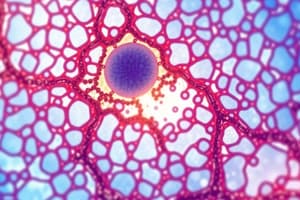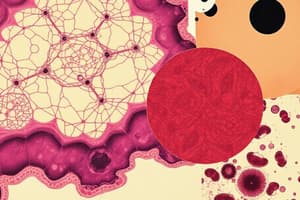Podcast
Questions and Answers
Which type of epithelium is found in the kidneys?
Which type of epithelium is found in the kidneys?
- Stratified squamous epithelium
- Simple columnar epithelium
- Simple cuboidal epithelium (correct)
- Stratified cuboidal epithelium
Which type of epithelium is responsible for gas exchange in the lungs?
Which type of epithelium is responsible for gas exchange in the lungs?
- Stratified cuboidal epithelium
- Simple columnar epithelium
- Simple squamous epithelium (correct)
- Stratified squamous epithelium
Which of the following types of epithelium has no provided example in the lab context?
Which of the following types of epithelium has no provided example in the lab context?
- Stratified columnar epithelium (correct)
- Simple columnar epithelium
- Simple cuboidal epithelium
- Stratified squamous epithelium
Where is stratified cuboidal epithelium typically found?
Where is stratified cuboidal epithelium typically found?
Which epithelium type would you expect to find in the small intestine?
Which epithelium type would you expect to find in the small intestine?
Flashcards are hidden until you start studying
Study Notes
Types of Epithelial Tissue
-
Simple Cuboidal Epithelium
- Composed of a single layer of cube-shaped cells.
- Primarily found in the kidneys, where it functions in secretion and absorption.
-
Stratified Cuboidal Epithelium
- Consists of multiple layers of cube-shaped cells.
- Located in mammary glands and salivary glands, which are not included in certain lab studies.
-
Simple Columnar Epithelium
- Made of a single layer of tall, column-shaped cells.
- Present in the small intestine, playing a vital role in nutrient absorption and secretion of digestive enzymes.
-
Stratified Columnar Epithelium
- Features multiple layers of column-like cells.
- No examples provided for this type in current lab studies.
-
Simple Squamous Epithelium
- Composed of a single layer of flat cells.
- Found in the lungs, where it allows for efficient gas exchange.
-
Stratified Squamous Epithelium
- Made up of several layers of cells, which can be flat or scale-like.
- Typically found on surfaces subject to abrasion, such as the tongue and skin, offering protection.
Studying That Suits You
Use AI to generate personalized quizzes and flashcards to suit your learning preferences.




